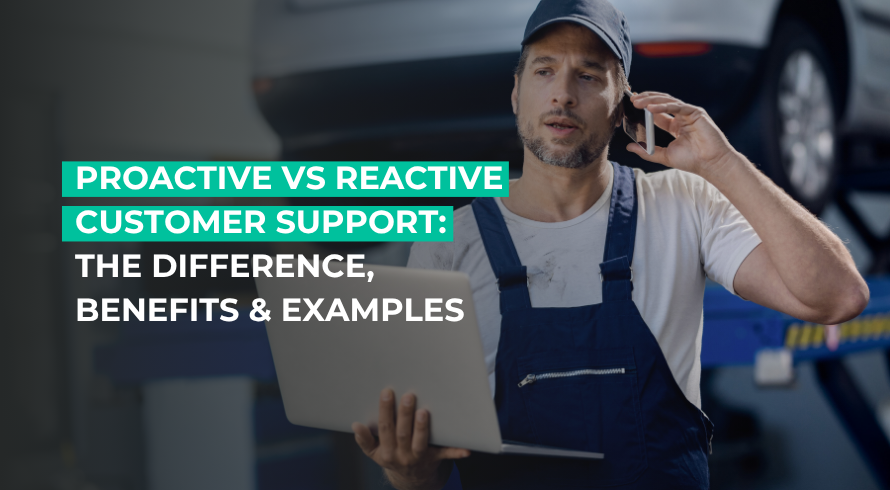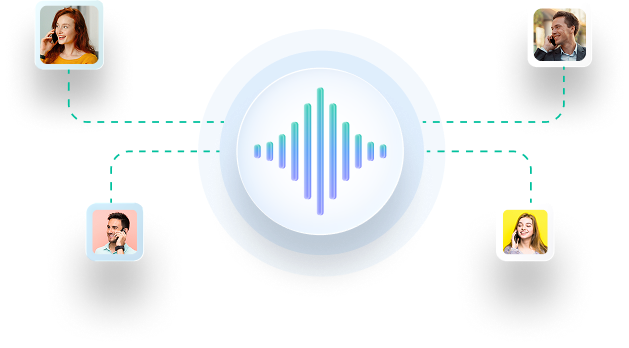With customers expecting fast solutions and instant responses, your business also needs to be on top of its game for customer support. Salesforce research finds that 61% of service professionals say their organizations cater to customers proactively. But only one-third of customers agree to that. This clearly means there is a huge gap in customer support, especially proactive support.
So what is proactive customer support, how does it contribute to customer experience, and why should your auto shop even care about it? Let’s answer all these questions here.
What is proactive customer support
Proactive customer support means that when you answer customer questions, you solve their problems even before they bring them up. It is a forward-thinking approach where you address customer needs before they highlight them. The aim is to stop problems from happening at all. The result? Improved customer satisfaction, trust, and long-term loyalty. This is an investment in nurturing better customer relationships and driving business growth over time.
But providing proactive customer support doesn’t just happen. You need to spend time understanding your customers. This means you will have to gather and decode customer data. Use that data to identify customer pain points, see trends, and their communication preferences as well. Once you have a good understanding of your customers’ wants, needs, and expectations, you can better predict their needs and personalise the proactive customer support for them.
How to provide proactive customer support
There are a few small steps you can take towards proactive customer support. Here are a few simple examples on how to start:
- Send out appointment reminders to your customers via SMS or email. This tells them you care about them. Plus, it also helps reduce no-shows and keeps your business’s schedule aligned.
- Keep your customers updated on their orders. Such as when it is ready for shipping and when it has been shipped. Updating them means you encourage transparent communication, and your customers will appreciate it.
- Share any additional information, troubleshooting guides, or best practices, etc, as well to provide value to your customers. Especially do this if they have recently made any purchases from you.
- Alert your customers timely of any outages, recalls, or any maintenance windows as well.
- Send them any latest industry news or developments that could keep them updated. This is another way to provide additional value.
Most importantly, don’t forget to get feedback after every service interaction. Send them a quick survey to fill out. This will again indicate to them that you care about their opinion and want to provide a better experience for them.
Benefits of proactive support
When you anticipate problems and think of a solution in advance, here’s what happens. You
- Get fewer incoming tickets/complaints as customers have already been given a solution before the problem comes up
- Can allocate your time, money and resources to other work that adds value to the business, instead of responding to repetitive customer requests.
- Build better customer relationships when you are proactive in communication and problem-solving. It helps you build trust.
As a result of all this, you turn one-time customers into loyal one who keep coming back, and also advocate for you. This eventually helps you grow your business, expand revenue and profits.
When you’re solving customer problems before they arise, you are bound to develop and strengthen your customer relationships. These customers will stick around, and be your loyal advocates. This helps your shop grow, bring in more revenue, and can help you expand.
Key requirements to deliver proactive customer service
Implementing a proactive customer support system doesn’t just happen overnight. There are several factors to consider before you get it right. It requires a clear plan and a few foundational steps:
- How and where to get accurate customer data. You will need to develop processes to gather your own business data. You will have to identify what data points are important for you, and what aren’t.
- Customer journey mapping, where you visually represent the customer’s experience with the company. You outline how they came in and what made them go. You’ll have to track and consolidate all these customer touchpoints.
- Automation to deliver timely and relevant outreach. When you are proactive in helping your customers, you need to automate many action items. For example, using auto repair software to send appointment reminders via SMS or email, or guides and other informational material over email.
You need automation tools and software so your staff doesn’t spend countless hours sending these to multiple customers.
What is reactive customer support
Reactive customer support, on the other hand, means catering to an issue after it has happened. Here, businesses respond to complaints and problems on the go, once the customer reaches out. The focus is to resolve problems as they come in, unlike proactive customer support, where the team makes the first move and contacts a customer.
A reactive customer service approach means you help customers and respond to problems in a prompt manner. It is still personalized, available 24/7, but it might require some automation tools to help.
Examples of reactive customer support
But, what does reactive customer support look like? Here are a few common examples:
- You respond to inbound questions and complaints for your business through phone, chat or email.
- Help customers troubleshoot steps after they ask for help (instead of sending them a guide upfront).
- Process returns when an issue is reported.
- Provide help with questions related to billing or appointment changes.
Both proactive and reactive customer support are important for a business. They both have their own set of advantages, and it is a good idea to have a system that combines both.
Benefits of reactive support
Solving customer problems as they arise is not a bad thing. You need to ensure you’re dealing with these issues promptly and in an effective manner.
Reactive customer support is helpful when you have a one-off, complex issue that comes about that no one could have predicted. As a business, you need to be prepared for any emergency situations that arise. When your business is able to deal with such situations and help customers, it develops trust and loyalty. It shows your customers that your staff is available when needed.
However, even this requires proper tools to assess the situation, respond fast, and take action. If responses lag, your customers will have to wait longer, which will break trust and create a bad experience for them. Plus, when your staff is overcommitted, they won’t be able to address any such situation, so you need to be prepared with the right technology.
The use of proactive and reactive customer service in different industries
Both types of customer support systems are used across different industries. These help businesses develop a long-lasting relationship with their customers. Many businesses also use various tools to achieve this. Let’s explore how each industry is tackling both systems.
Free Shop Handbook eBook
Discover the essential steps to create a compliant and effective Shop Handbook with our comprehensive eBook.
E-commerce and retail
In the fast-paced e-commerce and retail industry, businesses often offer proactive customer support by sending cart abandonment nudges, sharing back-in-stock updates, sending suggestions and recommendations based on past purchases. They also keeping customers updated with shipment notifications so customers know exactly where their order is. All this keeps the customers fully engaged. Platforms like Kaviyo and Attentive are great to offer such support.
Reactive support, however, means ecommerce businesses have a system set up where any live questions and issues are taken care of. For instance, live chat or email support might be thre for any order changes, or answering questions about sizing and fits. This is often done via Zendesk or Gorgias.
Saas/Technology
In the Saas or technology industry, businesses offer proactive support by sharing onboarding checklists or in-app walkthroughs. They could send a notice about any system downtime, or share information about upcoming features as well. This again, a great way to engage customers, and it is often done via Pendo or Appcues.
Reactive customer support in the Saas/technology industry means promptly responding when any technical or billing questions come in. This can be via live chat, help desk ticketing or email. The most common tools used for this type of customer support are Intercom or Zendesk.
Healthcare
Healthcare industry also sends out appointment reminders, pre-visit instructions or checklists, and even post-visit resources or helpful guides to reduce confusion and questions from the patients. Tools like Solutionreach help with sending out these reminders and proactively engaging customers.
Reactive customer support in the healthcare industry means businesses help customers reschedule or cancel appointments, answer urgent care questions by phone or chat. These are done via secure contact center platforms.
Financial services
The financial services industry also uses proactive customer support. They send out emails and messages regularly to warn customers against fraudulent activities. They even send out payment due dates, policy updates and other necessary information to keep customers updated. Notification platforms such as Twilio or Braze are great for sending out timely alerts.
Reactive support however, means handling account access issues, or disputes over transactions or even answering urgent questions on phone or chat.
Automotive (services and repairs)
Even in the automotive industry, there is an increased need for shops to implement a robust customer support system. With customers asking for more personalized experiences, shop owners must meet their needs with utmost precision.
Let’s take a look at some examples of proactive customer support in auto repair shops:
- Sending an email or SMS reminders for seasonal maintenance, such as switching to winter tires for colder months.
- A real-time text informing the customer of the status of their vehicle. For instance, “Parts on the way” or “Your car is ready for pick up.”
- Re-engaging a dormant customer who hasn’t visited the shop in a while with a “10% off on oil change” message.
For instance, auto shops can send reminders for seasonal maintenance, for instance, if they need to switch to winter tires as the colder months approach, or if they are due for an oil change. This again signals to your customers that you are proactive in helping them. Apart from that, you can suggest maintenance services based on the customer’s vehicle history and usage patterns, which inevitably extend the vehicle’s lifespan.
How to implement a proactive and reactive customer support system
Your business needs both proactive and reactive customer support systems in place, as both address different needs. But to develop a proper system, here is what you can do:
- Understand the reasons your customers come to you for help. Identify their most common pain points on your customer journey. Conduct surveys, talk to them directly, and gather as much data as you can.
- Start by building a formalized reactive infrastructure. Have clear response SLAs (service level agreements) in place. See which channels you will need for support, and build out a comprehensive knowledge base to guide your staff so they know how to deal with these situations.
- Then, as an extra support system, implement proactive customer support features. This includes your appointment reminders, other email campaigns, sending additional information, and guides. You can use this to address any pain points or trends you have identified when gathering data.
Tools to implement a proactive and reactive customer support system
There are so many tools that can help you implement these customer support systems into your business. From helping your team answer customer questions to resolving issues promptly, there’s a lot they can do.
Here is what you can use:
Chatbots
Customer service chatbots are available 24/7, which allows them to resolve customer issues without delays. They are also able to attend to individual customer needs, which gives them a personalized experience and shows the customers that you care about their needs.
AI voice agents
AI voice agents use artificial intelligence to understand, decode, and respond to human speech. It uses natural conversational interactions to answer questions and perform other tasks. These are also available 24/7 and can personalize the customer experience.
AI receptionist
AI receptionists answer calls in a natural, human-like voice after hours, on holidays and weekends. It can also receive any appointment requests, and perform other tasks for your business.
One such dependable solution is AutoLeap’s AI receptionist, designed to handle calls, answer questions, and manage appointments efficiently. Here are a few of the tasks it can take over for shops:
- Answer calls and frequently asked questions 24/7. Even after operating hours or on weekends when your staff is off, this agent can take calls, so you never lose business and opportunities.
- It can answer calls in English, French, and Spanish, allowing you to cater to customers who speak different languages.
- References hours of operations, the specific pricing for common services, and even locations and landmarks to better guide customers.
- Help customers book, cancel, or reschedule their appointments. They won’t have to wait for someone to go through the calendar or align techs’ schedules to manage appointments.
- Checks order status and even processes simple payments and transactions.
- Forwards calls to agents in case it is unable to handle any customer questions, making sure you don’t miss any valuable opportunities, and customers always get the right support.
Auto shops are increasingly adopting AI to manage customer queries faster and reduce manual workload. But also to build long-term and viable systems that help you help your customers.
Measure the impact of customer support systems
As you set up these systems for customer support, also outline a way to monitor the performance of your efforts. Before you begin, agree on the metrics you will be tracking to measure success. For example:
- First contact resolution is where you call agents are able to solve a problem when first contacted.
- Customer satisfaction which you can measure by sending our feedback surveys or by NPS.
- Number of deflected tickets means the number of complaints or issues that were resolved by the customer using a knowledge base or a chatbot instead of a human.
- After-hours calls mean the number of calls your business can take outside of official hours using various tools and technologies. For example, an auto shop can take calls outside of business hours using tools like AI receptionist that can help them capture customer data 24/7.
Wrapping up
Having both proactive and reactive systems in place helps your business serve customers no matter what the situation. The best teams and businesses have both in place. While a proactive customer service gives you a competitive advantage, and builds a solid relationship of trust when customers get timely, personalized service. Reactive, on the other hand, when you solve problems when customers come, it establishes you as a reliable business as well.
FAQs
What is an example of proactive customer support?
An example of proactive customer support is when you send your customer a guide for the equipment they just purchased, or you send them a reminder for their upcoming appointment.
What is an example of a reactive customer support?
An example of reactive customer support is when a customer calls to complain about a product/service through a customer hotline and your staff helps resolve it.
What are the top 3 skills of customer service?
The top three skills of customer service are communication, problem solving and relationship building.








